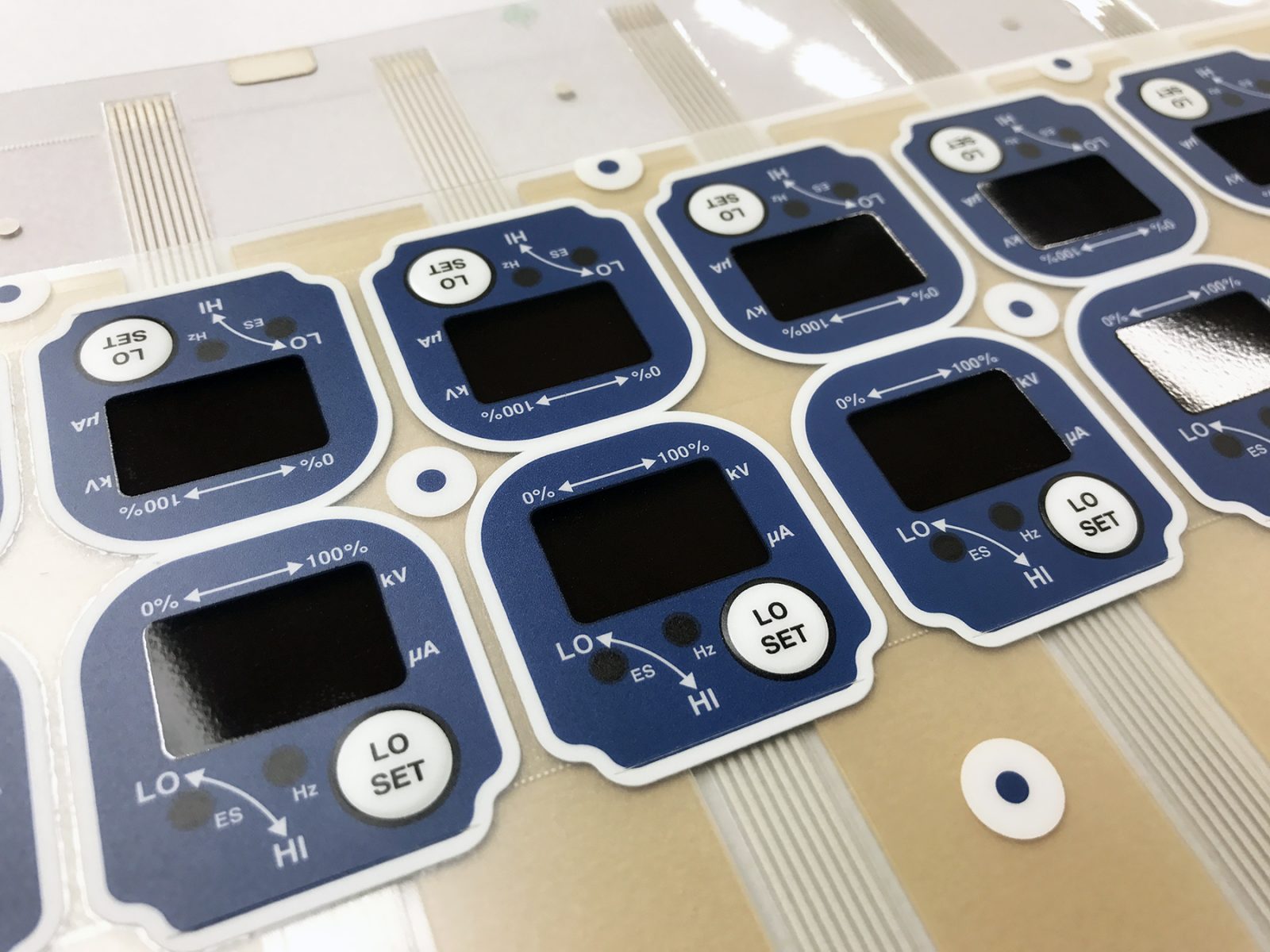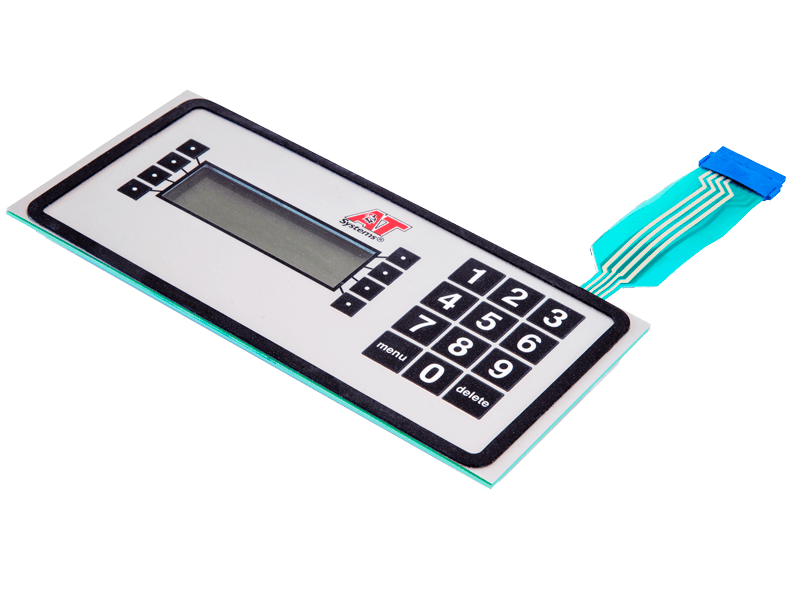What to Look for When Picking a Membrane Layer Change for Your Project
When you're picking a membrane button for your task, several key variables come right into play. You'll need to think about the products, layout, and how well it straightens with your brand.
Recognizing Membrane Change Elements
When you dive right into the globe of membrane buttons, it's necessary to comprehend the vital parts that make them operate. The button generally includes three main layers: the graphic overlay, the spacer layer, and the circuit layer. The visuals overlay supplies the visual interface, displaying buttons and icons you need for very easy navigation. Beneath that, the spacer layer warranties there's sufficient distance in between the circuit and the overlay, allowing the button to turn on without constant stress.
Comprehending how these layers function together assists you select a membrane switch that's reputable and fits your project demands. Pay close interest to the density and product of each layer, as these factors influence resilience and performance in various settings.
Material Selection and Its Effect
Picking the appropriate products for your membrane button can greatly affect its performance and durability. The option of substratum, generally polyester or polycarbonate, influences toughness and adaptability. Polyester is much more abrasion-resistant, while polycarbonate supplies far better clarity and strength.
Next, take into consideration the adhesive. It requires to hold up against environmental factors like moisture and temperature level adjustments. A solid glue assurances that your membrane button stays undamaged with time.
Don't fail to remember concerning the visuals overlay. The printing technique made use of, whether silkscreen or electronic, affects the button's looks and durability. Top notch inks will stand up to fading and scraping, maintaining a professional appearance.
Last but not least, consider ecological conditions. If your device will certainly be exposed to extreme chemicals or severe temperature levels, pick products designed to sustain these challenges. Your choices in materials will inevitably determine the switch's reliability and user satisfaction.
Layout Considerations for User Experience
Choosing the appropriate products lays the foundation for a successful membrane layer switch, but the design additionally plays a considerable function in customer experience. You'll wish to assess just how the layout affects use (membrane switch manufacturer). Maintain switches and symbols user-friendly and well-spaced, making it very easy for individuals to browse without complication

Color and comparison are additionally essential; assurance that your layout is visually enticing however still practical. High comparison assists individuals easily recognize switches, specifically in low-light problems.
Last but not least, reflect on the total aesthetic. A streamlined and modern-day layout can raise customer understanding and make your product much more appealing. Stabilizing functionality with an appealing style will certainly bring about a better customer experience and inevitably, a more effective item.

Environmental Factors and Longevity
When picking a membrane button, you require to take into account how it'll carry out in different atmospheres. Factors like temperature level resistance, wetness and chemical direct exposure, and mechanical wear can considerably influence its longevity. Recognizing these aspects will aid you choose a switch that stands up to your details problems.
Temperature Resistance Requirements
As ecological conditions can vary widely, understanding temperature level resistance is crucial for guaranteeing the durability of your membrane layer switch. You need to evaluate the temperature level array in which your gadget will certainly run. High temperatures can cause products to break down, resulting in failure, while low temperature levels might make components breakable and susceptible to cracking. See to it to inspect the specifications of the products used in the switch, like the adhesive and overlay, as they straight effect efficiency. It's likewise important to ponder prospective temperature level fluctuations and their effects on the button's dependability. By selecting a membrane layer switch with appropriate temperature level resistance, you'll boost its life expectancy and keep performance in difficult settings. Choose intelligently to avoid costly substitutes down the line.

Moisture and Chemical Exposure
Wetness and chemical exposure can significantly affect the efficiency and longevity of your membrane button, so it's essential to recognize the atmosphere in which it will certainly be used. Always consult the maker's specifications for chemical compatibility to assure your membrane switch keeps its capability over time. By prioritizing dampness and chemical resistance, you can improve the sturdiness of your switch in tough atmospheres.
Mechanical Damage
While you might focus on attributes like visual appeals and capability in your membrane switch, mechanical wear and tear can substantially influence its efficiency over time. Frequent pushing can lead to deterioration of materials, triggering issues like tactile responses loss or also switch over failing. Choosing a durable switch guarantees long life and dependability, protecting against costly replacements and downtime in your project.
Modification Options for Branding
When it comes to branding your membrane layer button, personalization choices are essential. You can pick design elements and colors that reflect your brand name, together with details logo design placement and size to improve presence. In addition, choosing the appropriate products and structures can boost the general appearance and feel, making your product attract attention.
Design Aspects and Colors
A wide array of layout elements and shades can make your membrane layer button not simply useful yet also aesthetically attractive, enhancing your brand name identification. Do not forget regarding textures; including a responsive element can enhance user experience and make your button stand out. By thoughtfully picking layout aspects and shades, you not just create a product that looks terrific yet additionally reinforces your branding continually and properly.
Logo Design Placement and Dimension
After settling your design elements and shades, the next step is to concentrate on logo design placement and size. Your logo is an essential aspect of your branding, so you'll desire it to stand apart without frustrating various other design components. Reflect on where your logo design will certainly be most visible and impactful; typical positionings include the leading or facility of the button.
Think of the size also-- also huge and it could outweigh useful components, as well small and it can get lost. Aim for a balance that permits your logo to be easily well-known while preserving the overall aesthetics. Don't forget to contemplate exactly how the logo lines up with user interaction. This focus to detail will certainly enhance both performance and brand name identification in your task.
Product and Structure Choices
Picking the best products and appearances for your membrane layer switch Source can greatly boost both its capability and visual allure. You'll intend to assess options like polyester or polycarbonate, as they supply longevity and resistance to put on. The appearance of the surface additionally plays an essential function; smooth surfaces offer a sleek look, while textured surface areas can boost hold and tactile comments.
Personalizing the materials and textures allows Go Here you to reflect your brand name identification properly. For example, you could pick a matte coating to convey sophistication or a glossy search for a modern-day touch - membrane switch manufacturer. Do not ignore shade choices, as dynamic shades can make your switch stand out, while soft tones can create a more classy look
Cost vs. Top Quality: Finding the Right Equilibrium
When you're handling the alternatives for membrane layer switches, stabilizing cost and top quality can feel frustrating. A lower-cost switch might save you money upfront, yet if it endangers capability, you can face greater replacement costs later on.
Try to find producers that provide an excellent mix of affordability and high standards. Research study their credibility and consumer testimonials to determine integrity. Sometimes, investing a little bit extra in top quality materials can save you from future migraines.
Additionally, take into consideration the lasting efficiency and warranty choices. A a little extra expensive button with a strong guarantee could show to be a smarter investment. Inevitably, it has to do with locating that pleasant spot where you fulfill your budget while guaranteeing your project's success.
Examining and Quality Control Protocols
While you may find the excellent membrane switch style, guaranteeing its top quality via rigorous screening methods is necessary for long-term success. Begin by verifying that the producer follows sector standards, such as IPC/WHMA-A -620, to guarantee a trustworthy product. membrane switch manufacturer. You'll intend to check for extensive screening approaches, consisting of ecological, mechanical, and electric evaluations
Ensure the switches go through sturdiness screening, replicating real-world use to recognize any kind of possible failures. Pay focus to the producer's quality guarantee procedure, which should include routine assessments and audits.

Don't neglect to ask for samples and conduct your very own examinations to verify compatibility with your project. Think about how usually the producer updates their methods; development in testing can lead to enhanced quality. By focusing on these testing and quality control procedures, you'll increase the likelihood of a successful and resilient membrane button for your application.
Frequently Asked Inquiries
How much time Does a Membrane Layer Switch Typically Last?
A membrane switch usually lasts anywhere from 1 to 10 million cycles, depending upon use and environmental aspects. You'll intend to think about your specific needs to assure it meets your long life requirements efficiently.
Can Membrane Changes Be Repaired if Harmed?
Yes, you can sometimes fix membrane layer switches if they're harmed, however it frequently depends on the degree of the damages. Small concerns these details could be reparable, while much more substantial damage normally calls for replacement for correct performance.
What Are the Typical Applications for Membrane Buttons?
Membrane layer buttons are commonly used in devices, clinical tools, and auto controls. You'll discover them in consumer electronic devices, industrial devices, and also gaming consoles. Their convenience makes them perfect for numerous individual interfaces and environments.
Exist Particular Accreditations for Membrane Buttons?
Yes, there specify certifications for membrane layer buttons. Look for UL, CE, and RoHS accreditations to guarantee safety and security and compliance. These qualifications show the button satisfies sector criteria for top quality and ecological security.
How Do I Guarantee Appropriate Setup of a Membrane Layer Change?
To guarantee proper installation of a membrane layer button, clean the surface area completely, align it carefully, and apply also pressure. Follow maker standards for glue curing time to maximize sturdiness and capability.
Final thought
When picking a membrane layer button for your job, maintain these vital variables in mind: prioritize resilient materials, focus on straightforward design, and consider personalization for your brand. Equilibrium expense and high quality by investigating credible producers with solid quality control protocols. By meticulously assessing these facets, you'll ensure your membrane switch not just meets your task needs however also enhances customer experience and shows your brand name identification successfully. Make an enlightened choice, and your job will prosper!